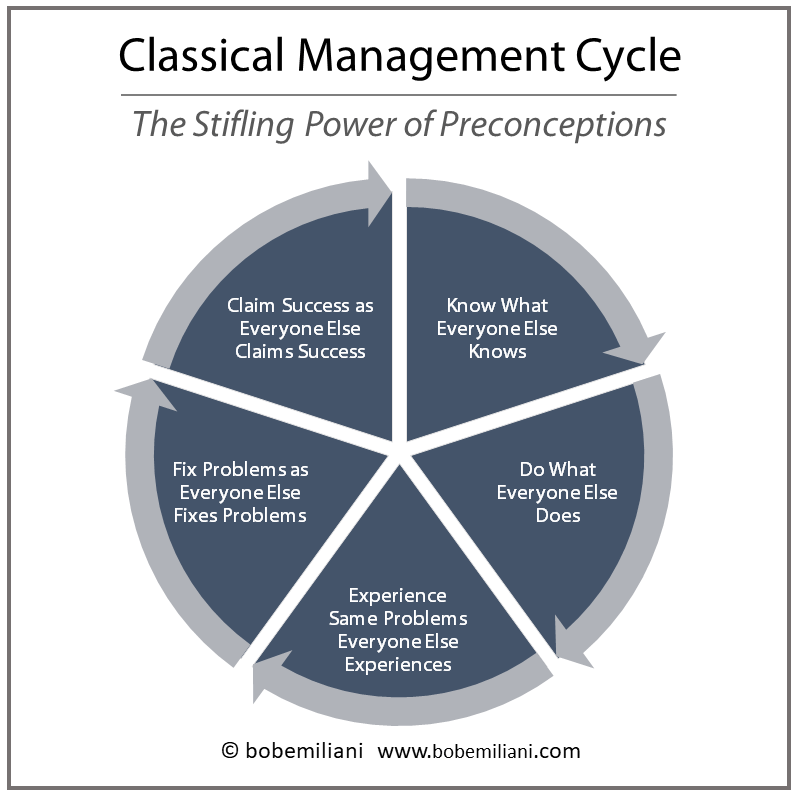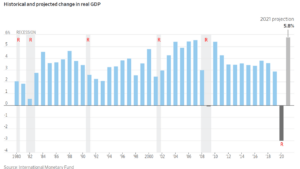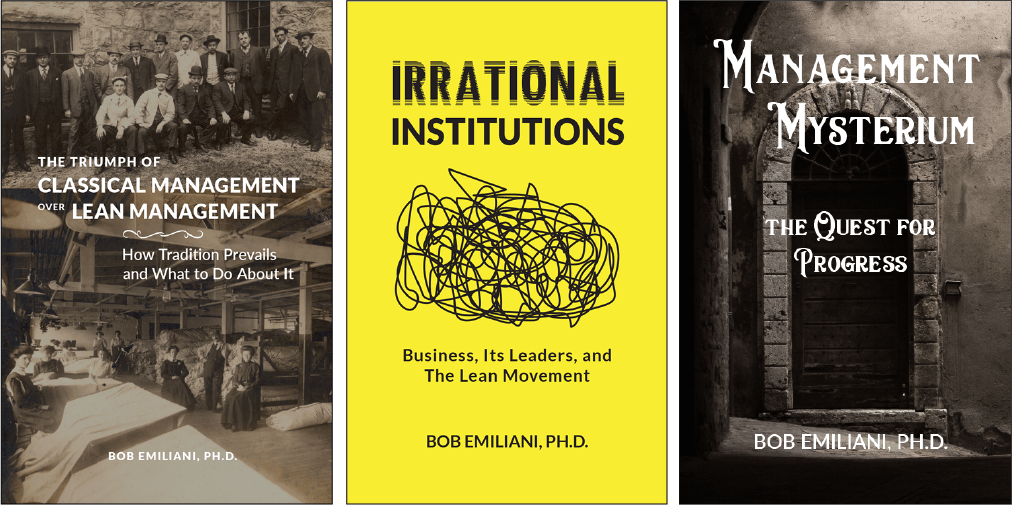
The strength of classical management lies in the confidence that is adherents have in its ever-lasting rightness. Based on ideas from 300 years ago, when business and society were markedly different, they remain with us today and are staunchly defended as correct for our time and beyond. The ideas are mystically seen as unchallengeable and unalterable rules of Nature despite great changes in business, society, human knowledge, and human behavior. Thus, we are forced to live under whatever outcomes, good and bad, that classical management delivers to us all. We are also forced to confront the reality that entrenched preconceptions continue to make Lean a niche management practice, unable to extend its reach beyond a few hundred companies out of the tens of millions of companies worldwide. The cycle of classical management, shown in the image above, assures there is no change in course overall.
A substantial part of the problem stems from the fact that the teaching of critical thinking in school is, at best, a 1 sigma process. It suffers from a 70% or greater failure rate regardless of the extent to which one is educated. Every teacher says they teach critical thinking, but few actually do, and those that do struggle to connect this important learning to students’ real world. Critical thinking means to question assumptions; to question the validity of claims such as those which are the foundation of 17th century moral philosophy and 18th century classical and neoclassical economics. Critical thinking means to examine the underlying premises (beliefs and assumptions) of things that are commonly taken to be true. Remarkably, the 70 percent or greater failure rate applies to everyone.
Scientific thinking, so much the rage today in Lean-world, is a subset of critical thinking. It’s good stuff, but not all scientific thinking is critical thinking. For scientific thinking to embody critical thinking, it must question the beliefs and assumptions, not merely rote step-wise evaluation of phenomena to better understand the world we live in. Critical thinking is more than problem-solving via the scientific method. While both have value, it is critical thinking that upsets the cycle of classical management. Within the classical management cycle there is lots of problem-solving going on, but the problem-solving is based on an unchanging set of beliefs and assumptions. That is why common problem-solving tends to reinforce and extend the status quo, and why efforts to make big leaps in improving leadership and management usually fail. It is why technical and behavioral training programs in industry produce little in the way of meaningful results. It is why teaching Lean management to people has a success yield much lower than 1 sigma, and thus why Lean is so easily and so often subsumed into classical management practice.
The result of a lack of critical thinking is the never-ending production of recurring problems, both small and large. One such large problem is the business cycle and economic recessions (see image at right, recession is denoted with red R). Since 1870, the U.S. economy has operated at a 2 sigma level, which means a 30% failure rate. There have been 12 recessions since 1950 resulting in a 17% failure rate. There has been an average of one recession every 6.6 years since 1980, a 15% failure rate. The current recession is a COVID-19 induced deep recession, however a recession due to more traditional causes was possible (likely?) in the next year or two without COVID-19 due to various asset and credit bubbles. So, while the failure rate appears to be decreasing, from 2 sigma to 2.5 sigma, the U.S. economy (or any country’s economy) is far from what one would term as “high quality” — despite more than 200 years of economic research and technical and policy solutions.
We must not forget that the damage done by a recession to employment and wages lingers many years after economists declare a recession to be over. These events have long-lasting consequences for workers and their families and make it difficult for people to have a good life due to the setbacks they experience every half-dozen years or so. And it makes it very difficult for young people (Gen X, Millennials, Gen Z) get established in the workplace (e.g. economically secure) or live a better life than their parents. They, perhaps more than any others, and truly dissatisfied with the current state.
To get to “high quality” in anything requires critical thinking, and that includes management. People need to better understand classical management and just how great a force it is at resisting or rejecting fundamental change in business and society. You can start by learning about the current state of leadership. Please consider reading these books:
Thank you.


